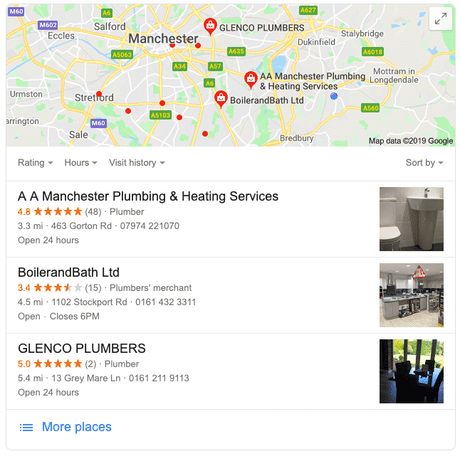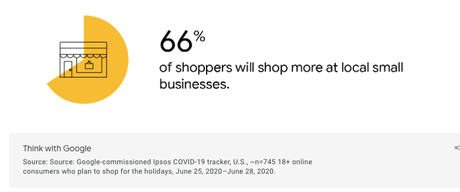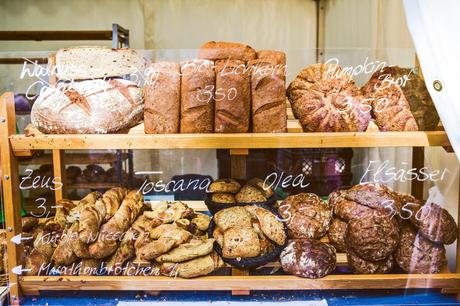66% of shoppers are intending to shop more locally since the covid-19 pandemic a Google Study has revealed. With this INCREASING to 74% during the christmas period as shoppers seek to avoid crowds of people, another Google Study found.
Local SEO is about unlocking not only the potential of those “shopping more locally”, but also tapping into those who were already shopping locally.

The above search data shows the increasing trend over the past 5 years for searches globally including the term “near me” – these local searches year on year grow hugely with one study suggesting that from 2018/19 to 2019/20 they almost doubled as Google continued to double down on it’s mobile first approach. Even with the current pandemic, this isn’t something that has reduced, and with the data from the Google Studies we know that these searches are only going to increase as time goes on – making local search ever more important.
In this article I will guide you through how to optimise your local business profile, whether you are looking to optimise for multi-location, or a single business / retail location. This guide is designed for you to jump in and out of, its written to be jargon free and is full of links for you to fulfill your potential and reach your target audience using organic search.
In order to help you set up and make the most of your business profile within organic search, below are a set of questions to help you optimise your online profile both within Google and your own website.
What is Local SEO?Your website and domain in general will give your business the ability to target the entire world as a ‘target audience’, but the reality is that you may not want too. You may want to target the UK, a region in the UK or a city or town such as ‘Manchester’.
Local SEO gives you that ability to target a specific Nation, Region or Locality.
Today, Local SEO has never been more important. With Local Lockdowns and travel restricitions meaning travel is less likely and users looking to shop more locally (see the Google studies above), optimising your website for local shoppers is a must. Local optimisations don’t always require code changes, it can be simple content optimisations, page name changes and other simple tweaks which give you an advantage on your competitors.
During these turblenet times, as we approach the festive period (i write this in October) it’s time to take advanage of your already capable website and put it infront of your customers locally, increase your sales using Local SEO.
It’s important that across the two big search engines you own your locations and brand. The way to do this is by claiming your locations using Google My Business and Bing Places.

These operate in much the same fashion, and importantly have feeds across other sites and into the vast mobile world. This means that almost every person carries this search within their pockets, searching for your brand or products could mean finding your local store … or your competitors.
Caring for your locations on these platforms could mean the difference between a sale or not.
Here are my top tips to optimise these platforms:
1) Ensure all information is accurate, spelled correctly, and as comprehensive as possible (fill every box, category, and attribute if you can). Ensure your name, address, phone number (NAP) are in the correct Google/Bing format.
2) Link directly to your local page (eg /manchester).
3) Upload photos of the store regularly, upload videos where possible.
4) Ask your customers to review you on GMB (this is shown to increase the incidence of GMB showing in search).
5) Turn on messaging through GMB, allowing customers to talk to you.
6) Don’t neglect your GMB/BP presence ever, update them regularly (if there is a lot, do them on a cycle). Can Your Site Structure Effect Local SEO?
As with any website, site structure and more particularly URL structure is one of the keys to search success. It can also be one of the first points of failure.
The first rule here is that whilst you can have an index of all your locations on a single page you should never simply have a single page of all your locations acting as your multi-location page. Users will find it complicated, annoying and frustrating, but search engines will just wonder what the hell is going on.
The best solution all round is to have each location on its own page, or rather set of pages where relevant. Here is an example of how this works:
your-store.com/locations < this is your index of stores
your-store.com/locations/manchester < an individual store/location page
your-store.com/locations/manchester/directions < store directions
your-store.com/locations/manchester/offers < specific location offers
As you see this structure offers a clean and simple approach. It would be easy for users to remember and easy to replicate by each store.
Additionally, for Google My Business etc you would link directly to /location-page rather than the homepage. This enhances the user experience and as such would be likely to reduce your bounce rate etc enhancing ranking overtime for this local page.
With each location page, every location should have the same specific information and in the same format. This is to say the same pieces of information appear on each page but should be unique for each location.
Those pieces of information are (though may not be limited to):
1) The complete location name, address and phone number (NAP), in the correct format as per Google requirements!
2) Location-specific content, and lots of it. This means testimonials, access information, photos, opening times, and offers.
3) Complete descriptions of how to get to your business using key transport infrastructure (whether that is buses, trains or motorways).
4) Specific on-page content (text) about the location, even if this is only a few sentences make the content unique to the page. << AHEM – UNIQUE CONTENT
5) Unique location-focused meta tags (title and description). This is what appears in search. Whilst it has little value for rankings, it’s what users see and hear (voice search).
6) Did I mention use amazing images? (and maybe video too)
With all the above you’ll have a really keen advantage over your competitors in 95% of cases. Most will just roll out the same content to every page, just changing opening times and that’s about it, so always go the extra mile for your users.
Well you already are if you are doing SEO, but that’s between you and I.
But really, you need to be doing a little more and the first big step along that path is to use structured markup language or microformats – also known as Schema. This really is something I’ve spoken about for a long time and has come into its own in the past 2 or 3 years.

For local businesses you should be using this structured data markup.
https://schema.org/LocalBusiness
These are simply tags which wrap around certain elements of your website, such as your address and opening times. Though if you sell products or services online you can also find markups for these too allowing you to let search engines know what the services are, how much they cost etc.
This direct translation of letting the search bots know then translates to information directly on search pages but also within voice search too and in mobile search (and can be used sometimes in mobile ads), its really a powerful tool.
You can test your ‘rich snippets’ using this Google Tool. Can Localised Content Improve Local SEO?
With the 66% of shoppers set to buy more locally due to covid19, local content is one of the tools which can really help boost SEO performance. Traditionally used by single location retailers or service providers, localised content is now becoming common across multi-location providers as it offers them a way to approach their target audience – however multi-location providers tend to look off-site for their local content with links to site whilst single location will look to build a content hub on-site.

On-Site
Whether you are looking to localise specific content using the url strucutre we talked about above, or within a blog (for example), the important thing is to have a clear target audience in mind. Whether its a complete market or a specific section – are you talking to your manchester audience as a whole, or your manchester e-commerce audience or your london audience etc … if you are posting for a single location does it make sense it appears on the wider blog or should it be filtered out to a single location’s page and not appear on the blog – in particular where its an offer or talking about say restrictions (covid related) … these are all things to consider, but localised content is really important because you are natually talking about the area you serve and the people you serve. They are going to be searching for their area, google is going to link your content with that area, your website with the area and naturally you should pick up a bit more market share – even if its only a small bit more.
Off-Site / Link Building
As with any website, the links your website can attain can help to improve your rankings. This is no different with local SEO.
Indeed, it’s often much clearer to see the results of a great link building strategy within a localised niche than it is non-localised or link building on more generic terms. This is because local search often reacts faster with ranking changes and often there is less competition (though this isn’t always the case). This means being local and building local authority links can quickly improve your local rankings.
The best places, as always, are industry websites, blogs, and long-term influencers. Other great places to look at for links include news publications and local events.
Ensuring links remain local and industry-led is the key to success. Don’t forget the links must always lead to the location page, this should then have a positive effect on your rankings.
If you are unsure where to start with link building get in touch for a chat and we can talk about your requirements, alternatively give FatJoe a try – a managed LinkBuilding Services provider. Do Reviews Help on Yelp & Google?
According to Hubspot’s 2020 state of the industry and Moz’s State of Search 2020, Reviews and Local Citiations can help boost local rankings. It is therefore not only important to ask for shoppers to leave a review but also to ensure that you are of course listed on Yelp and Trip Advisor etc.
Local citations are in effect the links/citations from large scale directory-type websites offering guides to areas or the such. A good example of this type of website is Yelp or TripAdvisor. There are also industry-specific directories that can provide citations, as can local news publications.

Building localised citations with links towards the Location Pages, not the main website page, is a key way of indicating to search engines this is the main page for this town, city or region.
Often you’ll see citation pages appear directly in the search for certain types of search. For example, “plumbers in Manchester,” “photographers in Manchester” or “local restaurants” are all likely to turn up some type of citation website, each listing a business with a possible link back to that business’ website.
As with GMB and BP (previously mentioned), you should optimise citations using the following steps:
1) Ensure all information is accurate, spelled correctly, and as comprehensive as possible (fill every box, category, and attribute if you can).
2) Link only to your location page.
3) Upload photos of the store regularly, upload videos to where possible.
4) Ask your customers to review you if appropriate on the platform (mainly for Yelp-type platforms).
5) Update your profiles on a regular basis. This is likely to increase your rankings within the database. Is Being Mobile-Ready Important for Local Search?
Honestly, if you’re asking this question – you probably ought to become a timelord and read this Google Webmaster Blog article from 2015. It in essence followed an update to the core algortihm called ‘Pigeon’ which was their first real mobile update, there have been many more since and Google is now really mobile-first.
What this meant for local search is that if your website isn’t mobile-ready and mobile-first then you will likely be missing a large % of your target audience. (ok, there are a very few markets such as finance trading where this isn’t always applicable – though to some degree it remains).
So here are a few tips to ensure your website is mobile ready and optimised:
1) Ensure your website loads quickly on mobile (4g speed not wifi), no more than 3 seconds on any page.
2) Ensure all functionality works as expected, including forms and checkout processes.
3) Use bigger fonts for text if required, in particular pay attention to standard paragraph text.
4) larger calls to action pay divdends in returns.
5) remove copy and images you don’t need on mobile, a simple UI/UX is better often.
You can test your mobile friendly rating using Google’s Testing Tool here.

Final Thoughts
We’ve kept this guide simple and to things which are fairly easy to implement in a short space of time, so that your business can grow locally as quickly as possible.
We know that there are many other things you could do, we know that content gap analysis could be a part of a local strategy, we know that you should be making tip to review your existing citations – but this guide is about getting you going and powering you forward – ensuring you are setup and ahead of the game.
If you’re stuck and have a question about Local SEO get in touch today.

